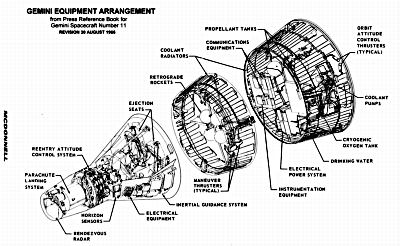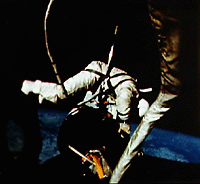
Gemini 12
NSSDCA/COSPAR ID: 1966-104A
Description
Gemini 12 was the tenth and final flight of the Gemini series, which bridged the Mercury and Apollo programs. This mission, carrying astronauts Jim Lovell and Edwin "Buzz" Aldrin, was scheduled to perform rendezvous and docking with the Agena target vehicle, to conduct three ExtraVehicular Activity (EVA) operations, to conduct a tethered stationkeeping exercise, to perform docked maneuvers using the Agena propulsion system to change orbit, and demonstrate an automatic reentry. There were also 14 scientific, medical, and technological experiments on board.
Mission Profile
Gemini 12 was launched from Complex 19 on 11 November 1966 at 3:46:33 p.m. EST (20:46:33.419 UT) and inserted into a 160.8 x 270.6 km Earth orbit at 3:52:40. At 7:32 p.m. rendezvous was achieved with the Gemini Agena Target Vehicle (GATV), which had been launched an hour and a half before Gemini 12. Docking with the GATV was accomplished 28 minutes later, at 4:14 ground elapsed time (GET) on the third orbit, relying heavily on visual sightings due to problems with the onboard radar. During insertion of the GATV into orbit an anomaly was noted in the primary propulsion system, so the plan to use the GATV to lift the docked spacecraft into a higher orbit was abandoned. Instead, two phasing maneuvers using the GATV secondary propulsion system were accomplished to allow the spacecraft to rendezvous with the November 12 total eclipse over South America at about 9:20 a.m. EST with the crew taking pictures through the spacecraft windows.
The first standup EVA took place with the hatch opening at 11:15 a.m. EST (19:29 GET) on 12 November and Aldrin standing on his seat with his upper body out of the hatch. The EVA lasted 2 hours 29 minutes during which Aldrin mounted a camera to the side of the spacecraft and collected a micrometeorite experiment, with the hatch closing at 1:44 p.m. On 13 November at 7:16 a.m. the crew reported little or no thrust was available from two of the maneuvering thrusters. At 10:34 a.m. (42:48 GET) the hatch was opened for the second EVA. Aldrin was outside the spacecraft at 10:38, attached to a 9 meter umbilical cord. He first worked in the hatch and nose area, and then moved along a handrail he had installed to the adapter section where he used foot restraints and tethers to position himself in front of a work panel mounted on the rear of the adaptor where he performed 17 relatively simple manual tasks. He then moved to the target vehicle adapter area and carried out another series of tasks, including use of a torque wrench while tethered. He attached a 30 meter long tether stowed in the GATV adapter to the Gemini adapter bar. About a dozen two-minute rest periods were scheduled during the EVA to prevent Aldrin from becoming overtaxed as happened to previous spacewalkers. Aldrin reentered the capsule at 12:33 p.m. and closed the hatch at 12:40 p.m. All tasks were accomplished and total EVA time was 2 hours 6 minutes.
At 3:09 p.m. Gemini 12 undocked from the GATV, moved to the end of the tether connecting the two vehicles, and began the tether experiment by moving in a circular orbit about the GATV. The tether tended to remain slack, but the crew believed the two craft slowly attained gravity-gradient stabilization. The tether was released at 7:37 p.m. On 14 November the hatch was opened at 9:52 a.m. (66:06 GET) and Aldrin began the second standup EVA which included photography, additional experiments and the jettison of unused equipment. The EVA ended after 55 minutes when the hatch was closed at 10:47 a.m. Minor fuel cell and thruster problems were reported, but did not affect the remainder of the mission.
The automatically controlled reentry sequence began with retrofire at the end of revolution 59 on 15 November at 1:46:31 p.m. EST. Splashdown occurred at 2:21:04 p.m. in the western Atlantic at 24.58 N, 69.95 W, 4.8 km from target point. The crew was picked up by helicopter and brought aboard the U.S.S. Wasp at 2:49 p.m., the spacecraft was picked up at 3:28 p.m. Total mission elapsed time was 94:34:31. All primary mission goals were successfully accomplished except performance of maneuvers using the Agena propulsion system due to fluctuations in the system noticed by ground controllers. There were minor fuel cell and attitude control thruster problems during the mission. The successfully performed scientific experiments were (1) frog egg growth under zero-g, (2) synoptic terrain photography, (3) synoptic weather photography, (4) nuclear emulsions, (5) airglow horizon photography, (6) UV astronomical photography, and (7) dim sky photography. Two micrometeorite collection experiments, as well as three space phenomena photography experiments, were not fully completed.
Spacecraft and Subsystems
The Gemini spacecraft was a cone-shaped capsule consisting of two components, a reentry module and an adaptor module. The adaptor module made up the base of the spacecraft. It was a truncated cone 228.6 cm high, 304.8 cm in diameter at the base and 228.6 cm at the upper end where it attached to the base of the reentry module. The re-entry module consisted of a truncated cone which decreased in diameter from 228.6 cm at the base to 98.2 cm, topped by a short cylinder of the same diameter and then another truncated cone decreasing to a diameter of 74.6 cm at the flat top. The reentry module was 345.0 cm high, giving a total height of 573.6 cm for the Gemini spacecraft.
The adaptor module was an externally skinned, stringer framed structure, with magnesium stringers and an aluminum alloy frame. The adaptor was composed of two parts, an equipment section at the base and a retrorocket section at the top. The equipment section held fuel and propulsion systems and was isolated from the retrorocket section by a fiber-glass sandwich honeycomb blast shield. The retrorocket section held the re-entry rockets for the capsule.
The reentry module consisted mainly of the pressurized cabin which held the two Gemini astronauts. Separating the reentry module from the retrorocket section of the adaptor at its base was a curved silicone elastomer ablative heat shield. The module was composed predominantly of titanium and nickle-alloy with beryllium shingles. At the narrow top of the module was the cylindrical reentry control system section and above this the rendezvous and recovery section which holds the reentry parachutes. The cabin held two seats equipped with emergency ejection devices, instrument panels, life support equipment, and equipment stowage compartments in a total pressurized volume of about 2.25 cubic meters. Two large hatches with small windows could be opened outward, one positioned above each seat.
Control, Propulsion, and Power
Attitude control was effected by two translation-maneuver hand controllers, an attitude controller, redundant horizon sensor sytems, and reentry control electronics, with guidance provided via an inertial measuring unit and radar system. The orbital attitude and maneuver system used a hypergolic propellant combination of monomethylhydrazine and nitrogen tetroxide supplied to the engines by a helium system pressurized at 2800 psi. Two 95 lb translation thrusters and eight 23 lb attitude thrusters were mounted along the bottom rim of the adaptor, and two 79 lb and 4 95 lb thrusters were mounted at the front of the adaptor. Power was supplied by a fuel cell power system to a 22- to 30-volt DC two-wire system. During reentry and post-landing power was supplied by four 45 amp-hr silver-zinc batteries.
Communications
Voice communications were performed at 296.9 MHz with an output power of 3 W. A backup transmitter-receiver at 15.016 MHz with an output power of 5 W was also available. Two antenna systems consisting of quarter-wave monopoles were used. Telemetry was transmitted via three systems, one for real time telemetry, one for recorder playback, and a spare. Each system was frequency-modulated with a minimum power of 2 W. Spacecraft tracking consisted of two C-band radar transponders and an acquisition-aid beacon. One transponder is mounted in the adaptor with a peak power output of 600 W to a slot antenna on the bottom of the adaptor. The other is in the reentry section, delivering 1000 W to three helical antennas mounted at 120 degree intervals just forward of the hatches. The acquisition-aid beacon was mounted on the adaptor and had a power of 250 mW.
Reentry
At the time of reentry, the spacecraft would be maneuvered to the appropriate orientation and equipment adaptor section would be detached and jettisoned, exposing the retrorocket module. The retrorockets consisted of four spherical-case polysulfide ammonium perchlorate solid-propellant motors mounted near the center of the reentry adaptor module, each with 11,070 N thrust. They would fire to initiate the spacecraft reentry into the atmosphere, with attitude being maintained by a reentry control system of 16 engines, each with 5.2 N thrust. The retrorocket module would then be jettisonned, exposing the heat shield at the base of the reentry module. Along with the ablative heat shield, thermal protection during reentry was provided by thin Rene 41 radiative shingles at the base of the module and beryllium shingles at the top. Beneath the shingles was a layer of MIN-K insulation and thermoflex blankets. At an altitude of roughly 15,000 meters the astronauts would deploy a 2.4 meter drogue chute from the rendezvous and recovery section. At 3230 meters altitude the crew releases the drogue which extracts the 5.5 meter pilot parachute. The rendezvous and recovery section is released 2.5 seconds later, deploying the 25.6 meter main ring-sail parachute which is stored in the bottom of the section. The spacecraft is then rotated from a nose-up to a 35 degree angle for water landing. At this point a recovery beacon is activated, transmitting via an HF whip antenna mounted near the front of the reentry module.
Gemini Program
The Gemini program was designed as a bridge between the Mercury and Apollo programs, primarily to test equipment and mission procedures in Earth orbit and to train astronauts and ground crews for future Apollo missions. The general objectives of the program included: long duration flights in excess of of the requirements of a lunar landing mission; rendezvous and docking of two vehicles in Earth orbit; the development of operational proficiency of both flight and ground crews; the conduct of experiments in space; extravehicular operations; active control of reentry flight path to achieve a precise landing point; and onboard orbital navigation. Each Gemini mission carried two astronauts into Earth orbit for periods ranging from 5 hours to 14 days. The program consisted of 10 crewed launches, 2 uncrewed launches, and 7 target vehicles, at a total cost of approximately 1,280 million dollars.
Alternate Names
- 02566
- Gemini12
Facts in Brief
Launch Date: 1966-11-11
Launch Vehicle: Titan II
Launch Site: Cape Canaveral, United States
Mass: 3762.1 kg
Funding Agency
- NASA-Office of Manned Space Flight (United States)
Disciplines
- Space Physics
- Life Science
- Human Crew
Additional Information
Questions and comments about this spacecraft can be directed to: Dr. David R. Williams
Personnel
| Name | Role | Original Affiliation | |
|---|---|---|---|
| Dr. George E. Mueller | Program Manager | NASA Headquarters | info@kistleraero.com |
| Dr. William C. Schneider | Project Manager | NASA Headquarters | |
| Dr. Charles W. Mathews | Project Manager | NASA Headquarters |
Selected References
- Gemini summary conference, NASA, SP-138, Wash, DC, Feb. 1967.
- Grimwood, J. M., et al., Project Gemini technology and operations - A chronology, NASA, NASA SP-4002, Wash., DC, 1969.

Diagram of the Gemini capsule. (Courtesy of NASA History Office.)
Gemini Books Online
On The Shoulders of Titans: A History of Project Gemini - NASA History OfficeProject Gemini Technology and Operations - A Chronology - NASA History Office
Gemini Summary Conference - NASA / Apollo Lunar Surface Journal
Gemini Home Page
Chronology of U.S. Astronaut Missions
- Mercury, Gemini, and Apollo
Gemini 12 Images
- Catalog of Spaceborne Imaging
More Gemini 12 Images
- Kennedy Space Center
More Gemini Diagrams
- NASA History Office

